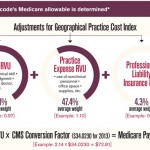When it came to determining reimbursement changes for DXA and VFA, the American College of Radiology shared with the RUC a survey of its members, who say that DXA scans took them an average of eight minutes to perform. They opined that the basis for calculating reimbursement for the work component should remain at its current level of 0.3 relative value units (RVUs), the scale used by CMS and most private insurers to determine physician reimbursement rates. Despite this recommendation, the RUC pegged reimbursement at 0.2 work RVUs, stating that it took physicians an average of only six minutes to perform a DXA. The ACR, along with other societies, sent a letter to Mark McClellan, MD, PhD, the CMS Administrator at the time, requesting that the RVUs remain at 0.3. CMS convened a refinement panel to allow the societies to present their case why the code should remain at 0.3. The ACR worked with ISCD to survey members across the United States to ascertain the actual work performed. The survey results indicated that the RVUs should remain at 0.3 or higher. This information was presented to the refinement panel. However, at the end of the refinement panel, a calculation of votes determined the final RVUs and the DXA RVU stayed at 0.2.
DXA also received a reimbursement cut from the practice expense portion of the Medicare calculation. CMS released a rule in 2006 changing the formula for practice expense. Previously, practice expense had been calculated using a top-down method; the new formula calculates direct practice expense in a bottom-up method. When the direct expenses for DXA were run through the new formula, reimbursement for the study was greatly reduced. Again, the ACR and several other societies told CMS that the calculation was unfairly reducing the reimbursement for DXA studies. In response, CMS reviewed the practice expense involved with DXA studies during its RUC meeting in San Diego earlier this month. The ACR, in conjunction with several other specialty groups, compiled practice expense information and presented its findings to the RUC at this meeting. At press time, CMS was still considering this additional information.
For its part, CMS has released a fact sheet noting that it has implemented substantial increases in payments for evaluation and management services such as office visits “so that physicians can spend more time with their patients to manage their care and achieve better outcomes.” The ACR surveyed the membership and worked with several other societies to assist in achieving the increase for E&M. And, “even after accounting for the payment decreases for DXA and CAD [computer-aided digital mammography], there would be hundreds of millions in additional spending directed to physicians to manage women’s healthcare, due to the increases for evaluation and management services.” What’s more, the CMS states that it is “revising coverage policy for bone-mass measurements to insure that women who need these tests to reduce the risk of osteoporosis can get them.”
The current Medicare reimbursement schedule will reduce practice expense reimbursement from the 2006 levels of $140 for DXA and $40 for VFA to $40 and $25, respectively, by 2010.
Possible Effects on Patient Care
CMS has yet to present any details on the promised policy revisions, however, and many observers believe that the current reimbursement schedule will have a profound impact on doctors’ ability to offer DXA and VFA to every appropriate candidate. “Our biggest concern is that it will limit access to care. The result will be that fewer people will be diagnosed with osteoporosis and fewer will be treated,” says Andrew Laster, MD, a rheumatologist and chair of the Public Policy Committee of the ISCD.

